Houseplant Pests and Control
PMC-10073 View this publication in PDF form to print or download.
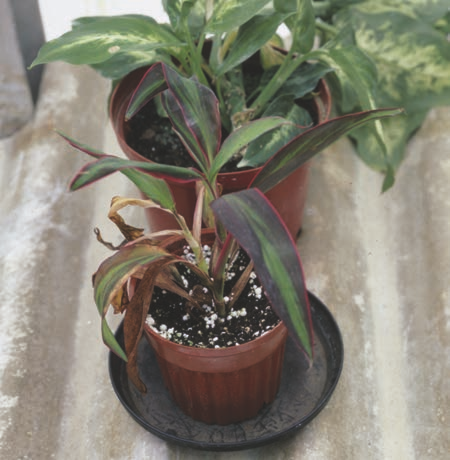
Erwinia stem rot
There is an increasing interest in the use of foliage plants in our interior living and working environments.
If the indoor environment is regulated and managed for optimum growing conditions, a wide variety of plants can be supported. Environmental conditions also impact the presence and extent of pest problems. Many interior plants are tropical or subtropical in origin and undergo stress when placed in locations where light, temperature or humidity is not optimal.
Plants become more susceptible to insects, diseases and other types of problems in less than ideal growing environments. Because interior conditions may be more suitable for various pests, they can easily multiply and quickly spread from one plant to another. Owners or plant maintenance personnel may encounter new or unusual pest problems that are not often seen in local outdoor plants.
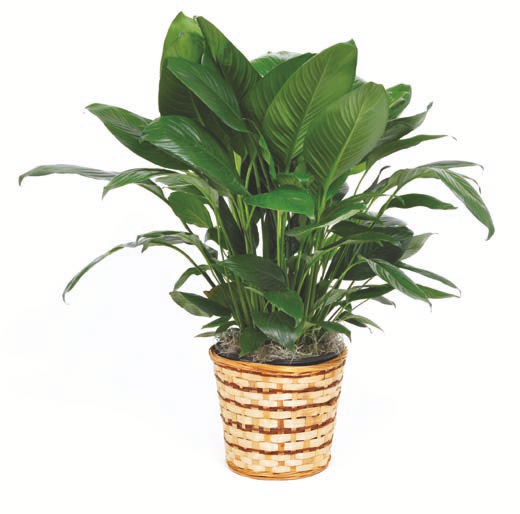
Identification of the pest is the first step in an effective pest prevention and/or control program. Once a positive identification has been made, an Integrated Pest Management (IPM) program should be developed. The use of pesticides in interior plantscapes (interiorscapes) is often difficult and undesirable because of the proximity to living or working areas. Management of the environment and the use of biological or physical controls are more attractive and can be effective using early detection, close monitoring and reevaluation.
Living plants incorporate beauty, function and a sense of calmness into homes and offices. Reducing the impact of pests will ensure the plants continue to add quality to our living environments.
Contents
- Diagnosing problems in the interiorscape
- Aphids
- Fungus gnats
- Mealybugs
- Scale insects
- Whiteflies
- Spider mites
- Thrips
- Cyclamen mite
- Occasional pests
- Gray mold (Botrytis spp.)
- Powdery mildew
- Water mold rots
- Pythium
- Phythophthora
- Root and stem rots
- Rhizoctonia
- Fusarium
- Fungal leaf spots
- Acremonium
- Alternaria
- Cercospora
- Colletotrichum
- Gloesporium
- Coniothyrium
- Curvularia
- Fusarium
- Helminthosporium
- Leptosphaeria
- Systemic bacterial infections
- Erwinia
- Bacterial leaf spots and wilts
- Pseudomonas
- Xanthomonas
- Virus diseases
- Noninfectious, abiotic plant disorders
- Integrated pest management
- About pesticides
- The pesticide label
- Pesticide formulations
- Five steps to safe use of pesticides
- References
- Sample label
Diagnosing problems
Diagnosing problems in interiorscapes is an important and necessary step for plant care. Once you notice a problem, you’ll need to determine the cause and plan a strategy to remedy the problem.
There are various approaches for making a diagnosis; the incident can be examined in isolation to determine what insect, mite or disease is causing the symptom. A better way of diagnosing a problem is to consider the situation in a holistic manner evaluating the environmental conditions along with cultural techniques and where the pest might have gained entrance. Often, pests and diseases attack when something else is affecting and weakening the plant. A close-up view with an overall examination will help you determine all the problems affecting the plants, rather than just the one that was first noticed.
Many plant problems exhibit similar symptoms; brown leaf tips, for example, may be a result of overwatering; or when moisture is too low. Conversely, some insect and mite problems are distinct; whitefly adults, for example, will move when an infested plant is disturbed, and spider mites leave their easily recognizable webbing. Sometimes the symptoms indicate several simultaneously occurring problems. The chart on the following page provides you with some general symptoms and possible causes to assist initial diagnostic work. Once probable causes are identified, look for more specific information and through a process of elimination, reach your final diagnosis. Remember to closely look at and examine the entire plant and consider the environment in which the plant is grown.
In some cases it may not be possible for you to make your own diagnosis. You can contact your local Cooperative Extension Service or other specialist to further identify your plant problems.
Diagnosing Plant Problems: Some General Symptoms and Their Possible Causes
| Symptom | Possible Causes |
|---|---|
| Wilting or drooping leaves |
Root disease/poor health Chemical damage Sucking insects such as mealybugs, scale insects or aphids Dry soil Overcrowded roots |
| Pale green or yellow leaves of all ages |
Too much light Insect or mite feeding damage High temperatures Nutrient deficiency Root rot |
| Pale green or yellow older leaves |
Nutrient deficiency, especially nitrogen Poor root health Too little light Insect or mite feeding damage |
| Leaf spots |
Fungal or bacterial infection Chemical injury Overwatering Sun scorch Lack of water Insect feeding damage |
| Brown or yellow leaf tips |
Underwatering Overwatering Excessively dry soil between waterings Nutrient toxicity Excessive soluble salts in the soil Mechanical injury Chemical injury Low relative humidity |
| Leaf drop |
Sudden environmental changes (light intensity, temperature, transplanting, humidity) Root rot Poor root health |
| Leaves are droopy and covered with a shiny, sticky substance or are covered with a dull black mold. Insects may or may not be present. |
Aphids Mealy bugs Scales Whiteflies |
| Leaves covered with gray webbing or are speckled and pale green. |
Spider mites |
| Leaves are silvery green in color with tiny black specks on their surface. | Thrips |
| Roots are brown and mushy, and the outer covering can be pulled off and separated from the center. Above ground symptoms are varied. | Root rot Poor root health A toxic solution being poured into the pot Overwatering Underwatering |
Aphids
Description and biology
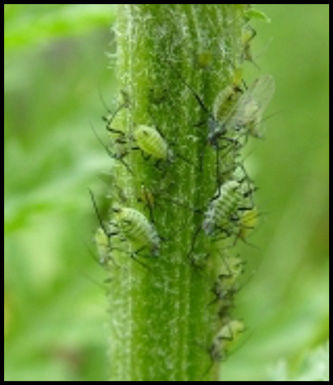
Aphids
Aphids are small (1/16 to 1/18 inch long), soft-bodied insects with mouthparts that are made for piercing plant tissue to suck the plant fluids. Aphids resemble tiny pears in shape and may be brown, green, red, yellow, black or other color. Some aphids secrete a waxy material that gives them a woolly or cottony appearance. Aphids have long legs and long, slender antennae. Most species have two straw-like projections (conicles) on the posterior of their bodies. Conicles are unique and used to distinguish aphids from other insects. Adult aphids are usually wingless, but most species also have winged forms appearing at certain times of the season or at high aphid populations. Young aphids are smaller versions of wingless adults and may differ in coloration.
Aphids produce many generations each year. Most aphids reproduce asexually with females giving birth to live young (parthenogenesis). The young aphids, or nymphs, shed their skin (molt) approximately four times before reaching adulthood. In warm conditions such as the interiorscape, the life cycle from birth into mature adults is less than two weeks; each adult aphid can produce 100 young per week, resulting in a rapid population growth. Some aphid species mate and lay eggs at the end of the summer season. These eggs serve as a hardy overwintering stage. Young nymphs emerge in the spring. In the interiorscape, aphids have no need for winter survival, and the warm atmosphere contributes to successful population expansion (or on occasion, population explosion.)
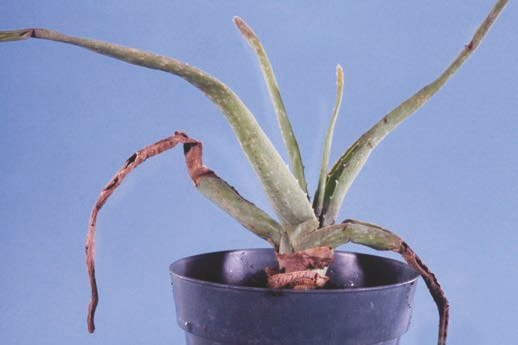
Aphid damage on aloe vera plant
Signs and symptoms
Puckered, curled, distorted and discolored leaves are often indications aphids are present. Close examination may reveal aphids traveling across leaves or stems of plants. Aphids secrete honeydew, a sticky substance that supports the growth of dark-colored sooty mold. Its presence on plant surfaces can also indicate aphid activity. Plants supporting aphid populations generally appear to be lacking vitality, and new growth is stunted and disfigured. Some species of aphids feed on parts other than the leaves and shoots; one species, which attacks lettuce, feeds on plant roots and remains in the soil throughout its life cycle.
Constant aphid feeding may kill growing tips to deform growth and the entire plant. Some species of aphids transmit viruses. The virus is introduced to the vascular system of the plant when the aphids pierce and feed on plant tissue. Certain species of aphids inject toxins, which may distort plant growth.
Prevention and control options
Aphids are fragile insects that often can be dislodged from the plant with a strong spray of water. Insecticidal soaps registered for use in the interiorscape provide good control, especially for spot treatments. There are several biological control agents that can be used to successfully control aphids. The familiar lady beetle, lacewings and the larvae of syrphid (or hover) flies are some examples. Insecticidal chemicals registered for use in the interiorscape can effectively control aphids but may not be necessary if the aphid population is closely monitored and effectively reduced with an initial spray of water and insecticidal soap.
Fungus gnats
Description and biology
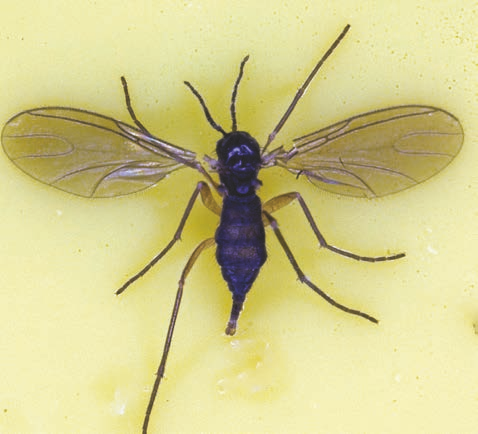
Adult dark-winged fungus gnat (Sciaridae)
Fungus gnats are small, delicate, flying insects (about ⅛ inch long). What most people see flying around their interiorscape or greenhouse and refer to as a “fungus gnat” may actually be one of several kinds of minute flies, most of which feed on decaying organic debris and fungi. The two families — Sciaridae, the dark-winged fungus gnats, and Mycetophilidae, the fungus gnats — include the more common species. Fungus gnats generally breed in leaf litter or other decaying organic material in the outdoor environment and may find their way into the home or greenhouse. Once inside, adult females lay eggs in houseplant containers or other indoor areas of decaying organic material or fungi.
Eggs usually hatch within a few days. The slender, legless, white or opaque larvae have darkened heads and may be found in the potting soil. The larvae feed on organic debris, plant roots or the stem at the soil level. Once fully developed, the larvae stop feeding and pupate in or on the substrate and soon develop into the adult gnats. Because of their relatively short life cycle (approximately 12 days for some species), fungus gnats seem to suddenly appear from nowhere in great numbers.
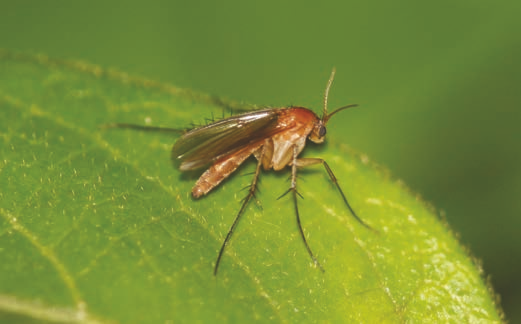
Adult fungus gnat (Mycetophilidae)
Signs and symptoms
Mild infestations of fungus gnats may not yield any recognizable plant symptoms. A few of the adult gnats may fly around the plants. Severe infestations with larvae feeding extensively on plant roots and lower stems often result in a wilted, drooping plant. You may see the tiny larvae and the damage to plant roots by gently probing and examining the soil with the help of a magnifying lens. Root rots also are more prevalent in damaged roots. The presence of fungus gnats may be an indication of excessive moisture, algae growth or organic buildup in the soil.
Prevention and control options
Control of fungus gnats begins with reducing the moisture content of the infested soil. Less frequent watering helps dry preferred habitats. Places that collect water or grow mold, algae and fungi should be cleaned with household cleaners. Damaged, diseased or decaying plant material should be removed to decrease the growth of fungi.
For houseplants, scraping off about ¼ inch of the soil and replacing it with an equal amount of sand, vermiculite or perlite can reduce fungal and algae buildup in the soil surface. Good plant care and sanitation is helpful in deterring fungus gnats from invading houseplants.
In severe infestations, a pesticide registered for use on fungus gnats in an interior environment may be applied according to label directions. A formulation of Bacillus thuringiensis (Bt) specific for fungus gnat larvae is also available.
Mealybugs
Description and biology
Mealybugs are small (about ⅛ inch), soft-bodied insects that appear to be covered with a white or gray powdery or waxy outer layer. They are generally oval and flattened, and many have white, waxy filaments extending out from their bodies. Mealybugs can move freely but very slowly on host plants, often clustering together on plant surfaces as they feed. They have mouthparts that enable them to suck sap from plant leaves, shoots, stems and roots.
Adult female mealybugs are wingless and are usually seen on the plants. Adult male mealybugs are very small and gnatlike with a single pair of wings. The males are short-lived and do not feed during the brief adulthood. Young mealybugs (nymphs) resemble the females but lack the copious waxy coating. Nymphs forming a mass of cottony filaments transform into adult males. Female nymphs continue to grow, exuding the waxy outer covering until adulthood.
Mealybugs may produce one or more generations each year, depending on species and environmental conditions. A young mealybug can reach adulthood within two to eight weeks, depending on temperature and humidity. Female mealybugs lay hundreds of yellowish or orange eggs in cottony egg sacs. Upon hatching, the young nymphs crawl out of the sac and across plant surfaces. The tiny nymphs also may crawl or are moved to other plants on air currents. All mealybug life stages may be present on a plant at the same time, especially in an interiorscape with a favorable atmosphere.
Signs and symptoms
Drooping, stunted or distorted leaves often indicate the presence of mealybugs. Close examination, especially where the leaves are attached to the plant, may reveal a cluster of cottony, waxy white mealybugs. Other places to look include the undersides of leaves, cracks and crevices in stems and other sheltered places on the plant.
Like aphids, mealybugs produce honeydew when feeding to provide a substrate for sooty mold growth. The plant often will appear to be covered with a brownish or blackish sticky residue of sooty mold growing on the honeydew. If you suspect mealybugs, also examine the plant for aphids because the signs and symptoms are similar for the two insects. Remember that some species of mealybugs may be found on the roots and that some above-ground symptoms may indicate a below-ground problem.
Mealybugs consume plant fluids, causing the plant to lose vigor. Plants with mealybug infestations often grow slowly with reduced new growth. The honeydew secretions and subsequent sooty mold growth result in unattractive plants. A large population of mealybugs can result in severely stunted or even dead plants. Some species of mealybugs transmit plant viruses or inject toxins that will cause growth distortions.
Prevention and control options
Individual mealybugs can be removed with a cotton swab dipped in rubbing alcohol or by removing infested plant parts. Biological control agents that prey on mealybugs are available. The mealybug destroyer (Cryptolaemus montrouzieri) can efficiently reduce a large population to allow good control using follow-up treatments methods. Insecticidal soaps and other specific pesticides are registered for control of mealybugs in interiorscapes.
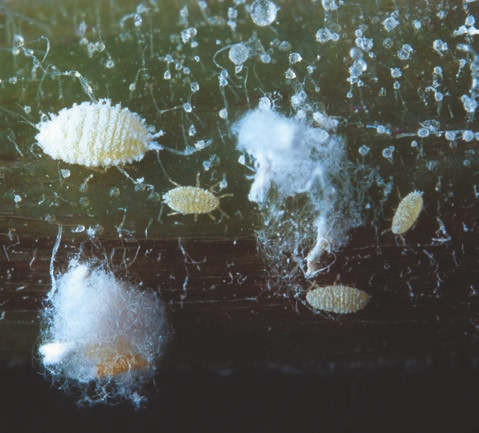
Mealybugs
Scale Insects
Description and biology
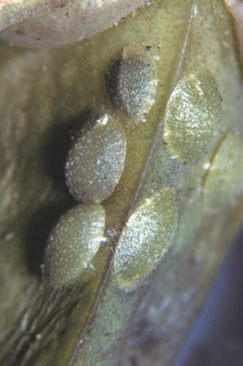
Wax scales
Scale insects are sap-sucking insects (about 1/16 to 1/18 inch in diameter) resembling a disclike shield, a rounded wart or a blemish adhering to the leaves and stems of plants. Because of the unusual physical appearance, scale insects often go unnoticed or misdiagnosed on plants. The adult female and many immature scale stages are immobile and covered with a hardened waxy or cottony shell or shield. The covering has different shapes, sizes and colors and is unique to a particular species. The adult males are tiny, gnatlike and rarely seen or found on the plant.
There are two main groups: soft scales and hard, or armored, scales. The females of both types have a shell-like covering that typifies the uniqueness of all scales. The soft scales have a covering that cannot be removed from the body without harming or killing the insect. The armored scales can be separated from the coverings after they have settled on the plant. Like aphids, soft scales produce sticky honeydew to support the growth of sooty mold. The armored scales do not produce honeydew and no shiny or sooty plant tissues appear.
In the interiorscape, scale insects may produce only one or more than eight generations in a single year, depending on the species and the available host. In a generalized life cycle, the stationary female produces several hundred eggs beneath the protective covering. These eggs hatch into “crawlers,” and begin to disperse across the plant or are carried by air currents to nearby plants. The tiny crawlers then settle in one place, where they stay and feed for the rest of their adult life.
Signs and symptoms
Plants that are infested with soft scale insects are often covered with sticky honeydew, which in turn provides a growing medium for sooty mold. The leaves and other parts of infested plants may show signs of water stress. Drooping or yellowing leaves or branches often indicate scale activity in that particular area or a nearby area. Hard scale insects may be more difficult to notice since they don’t produce honeydew. Plants infested with hard scales often appear as if they lack water or overall vigor. The leaves and branches may turn yellow or brown and fall off.
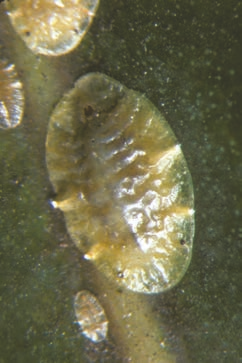
Green shield scale
Prevention and control options
Because of the protective coating, scale insects can be difficult to control. Assess the amount of damage and attempt to remove heavily infested plant parts. Spraying the plant with a strong jet of water can dislodge young crawlers. Predators and parasites are available and can be employed to combat scale insects. For instance, Metaphycus is a parasitic wasp used to control scale. Insecticidal soaps, oil sprays and systemic insecticides are available and registered for scale control in interiorscapes. Be sure to read and follow the label for correct application.
Whiteflies
Description and biology
Whiteflies are very small insects (1/16 to 1/10 inch) that have sucking mouthparts. The adults resemble tiny white moths. When an infested plant is moved, adult whiteflies leave the undersides of leaves, forming a cloud in the air. Immature whiteflies, when newly hatched, are mobile, tiny crawlers. After crawling for a brief period, they molt, losing their legs and antennae and becoming sedentary and scalelike nymphs. Immature whiteflies in the stationary stage feed by sucking plant sap. They consume far more than they can use and the excess is excreted as honeydew. Once on the plant surface, the sticky honeydew serves as a substrate for sooty mold growth.
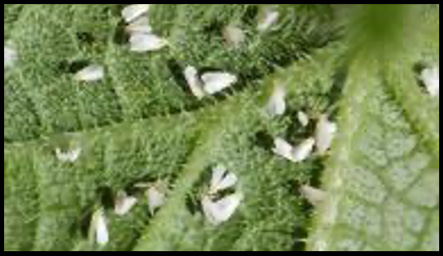
Greenhouse whitefly
Whiteflies go through a complete life cycle, including several nymph stages and a pupae stage following the crawler stage. Specific identification is easiest at the immature nymph stage because all adult whiteflies look similar. Most whiteflies breed continually throughout the year, and have a wide variety of preferred host plants. The warm temperatures and usually predator-free environment of interiorscapes provide an ideal situation for whitefly activities. The most common species found on interior plants and in greenhouses is the greenhouse whitefly, Trialeurodes vaporariorum. The short life cycle of 21 to 36 days from egg to adult, depending on temperature, often results in a sizable population in a relatively short time.
Signs and symptoms
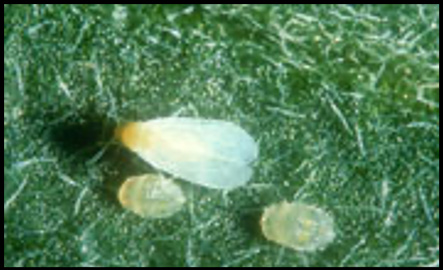
Greenhouse whitefly, multiple life stages
The first sign of whitefly activity is most often the appearance of white, mothlike adults flying off a disturbed plant. Adult whiteflies usually inhabit the lower side of mature leaves and a quick check can startle the whiteflies into flight. Immature stages (instars) can be found on young, fully expanded leaves. An infested plant may show signs of wilting, leaf yellowing and reduced growth, or leaves may become brittle and dry. Like aphids, whiteflies also excrete honeydew and sooty mold may develop. Some whiteflies transmit viruses from one plant to another.
Prevention and control options
Adult whiteflies are often difficult to control because of their ability to fly. They are attracted to yellow sticky cards that are readily available for purchase. The sticky cards are a useful tool for trapping and monitoring the population of adult whitefly. Insecticidal soaps are effective and can be used for whitefly control. A handheld vacuum is sometimes used to suck up the adults. Vacuum the plants in the cool morning hours while whiteflies are still sluggish (be sure to destroy the captured whiteflies in the vacuum bag).
Chemical control of whiteflies may be considered. Due to the ability to multiply rapidly, repeat applications and close monitoring are needed for successful chemical control. Several biological controls are available, including the parasitoid wasp Encarsia formosa. This wasp is one of the first biological controls used in commercial greenhouses with records dating back to the 1920s. The wasp lays eggs in the nymphs or pupae stages of the whiteflies. The content is then used for the development of the parasitoid wasp to adulthood.
Spider mites
Description and biology
Spider mites are tiny web-spinning mites. They are usually 1/20 of an inch or less in length and are difficult to see without the assistance of a hand lens. To the unaided eye, spider mites look like small, fast-moving, reddish, yellow or greenish colored dots on the surface of the host plant. Their presence, however, is often first indicated by the characteristic silk webbing the mites produce on infested plant parts. Adult mites have oval bodies and eight legs; female spider mites usually have two large, dark spots on each side of their bodies, whereas males do not. Both females and males have pale bristles covering their bodies and bright red eyespots near the front of their heads. Young mites resemble the adults, although the immature mites have only six legs when they first hatch and lack the darkened body marks common on adult females. Spider mite eggs are round and semitransparent when they are first laid, becoming more opaque as they approach maturity.
Spider mites may have several generations within a single season. In warm, often-dry locations such as the interiorscape, they may continually reproduce year-round, completing a single generation in as little as one or two weeks. The temperature influences egg-laying activities and development of adults. In ideal conditions, each female may produce 100 eggs or more. This allows the mites to infest a plant very quickly. The two-spotted spider mite, Tetranychus urticae, is a common pest in interiorscapes (as well as in greenhouses) and can be quite destructive to individual plants or entire collections. The mites’ unsightly webbing and feeding activities contribute to overall decline and poor appearance of the plant.
Signs and symptoms
Often, the most noticeable sign of a spider mite infestation is the webbing over plant parts. The first sign is generally a spotted or stippled pattern on the leaves where mites suck out the cell content. As the mites continue to feed, more webbing is produced and noticeable. You can often see the tiny mites as they scurry across the scaffold-like webbing. Infested leaves begin to yellow and eventually drop off. A severe infestation of spider mites often results in a plant so unsightly and unhealthy that the only recourse is to discard it.
Prevention and control options
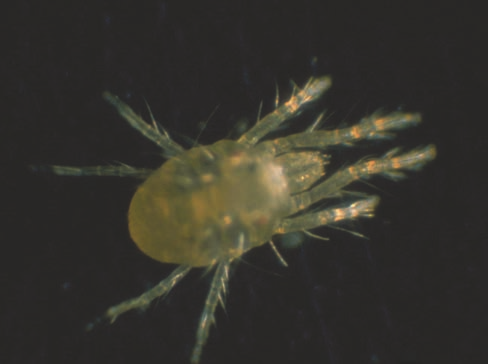
Two-spotted spider mite
Spider mites prefer hot, dry conditions with low relative humidity (unfortunately, some insect pests and plant diseases thrive at high humidity). Dusty environmental conditions can contribute to the success of a population, and water-stressed plants can attract spider mites. Avoiding dry conditions while maintaining healthy plants can reduce the chance of a spider mite infestation. Frequent misting can increase the local humidity of individual plants, making them less attractive to spider mites.
A predatory mite, Phytoseiulus persimilis, is a commercially available biological control for spider mites, along with a few other predatory species. Predatory mites consume both eggs and adults of the two-spotted spider mite, making them effective when employed and released as directed by the supplier.
Chemical treatments for spider mites include insecticidal soaps (those labeled for use against spider mites, read the label) or miticides approved for use in interiorscapes and specific plants to control spider mites. Insecticidal soaps labeled for spider mites may be especially useful for spot treatments of localized infestations. Heavily infested plants may be removed from the collection to avoid outbreaks since the spider mites can rapidly multiply.
Thrips
Description and biology
Thrips are small (1/20 inch or less), slender, elongated insects. The adult female thrips have two pairs of fringed wings, which they hold flat over their back when at rest. Young thrips resemble adults but lack the characteristic fringed wings. Some thrips are predators of other insects and mites, serious plant pests or both predaceous and plant feeding. In the interiorscape, thrips damage plants by rasping and scraping the plant surfaces, leaving brown or silvery scars on the infested tissues. Adult females lay 25 to 200 eggs in plant tissue. The newly hatched immature thrips feed for approximately one week before pupating either on leaves or in soil, depending on the species. The adults emerge four to 14 days later and there may be several overlapping generations each year. Although there are many species of thrips, the most common species in interiorscapes is the Western flower thrips (Frankliniella occidentalis).
Signs and symptoms
Thrips activity is most apparent when the insects feed on the plant. White or silvery patches are the result of the rasping and scraping feeding methods. Tiny, black fecal pellets also can be found in damaged areas. Thrips often move fast and remain hidden on leaves or flowers. The first signs are usually the characteristic silvery areas with tiny black specks. Leaves and flowers may become distorted as a result of the damage.
Prevention and control options
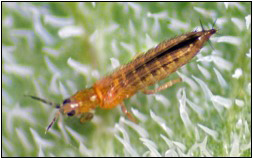
Western flower thrips
Many thrips species are deterred by high relative humidity. Misting plants may be helpful, but unfortunately, other insect pests and plant diseases prefer a high humidity. Predatory mites that prey on thrips such as Amblyseius cucumeris are commercially available. The minute pirate bug, Orius insidiosus, is a “generalist” predator feeding on various insect pests including mites, aphids and moth eggs. It also aggressively attacks all mobile stages of thrips and is now commonly used as a biological thrips control. Beneficial nematodes (Steinernema carpocapsae) have recently become available as a control of early premature thrips stages (larvae and pupa). Insecticidal soaps registered for use against thrips in interiorscapes can be used as spot treatments when needed. Several insecticides registered for use in interiorscapes also list thrips as a targeted pest on the label.
Cyclamen mite
Description and biology
The cyclamen mite, Steneotarsonemus pallidus, is a minute (1/100 inch) pest of cyclamen, African violet, strawberry and several other plants. Adult cyclamen mites are pink to brown in color, but the young mites are translucent and almost colorless. The mites feed and lay their eggs on the young, newly developing leaves at the crown of their host plant. Because of the tiny size of the mites, the easiest identification is by recognizing symptoms resulting from their activity. As the infested leaves begin to grow and expand, damage becomes apparent; leaf margins are cupped, puckered or distorted and leaf stems fail to elongate.
Under ideal conditions, cyclamen mites may complete an entire generation in less than two weeks. They infest several different host plants and crawl from plant to plant where leaves touch.
Signs and symptoms
As described above, infested leaves are curled and malformed as they develop and expand. The leaves are often brittle, dwarfed, thickened or cupped. Flower buds are deformed or withered and seldom develop into flowers. If flowers open, the petals may have streaks of darker colors.
Prevention and control options
Preventing cyclamen mites from entering the interiorscape is perhaps the best management tool. Once the mites become established, they are difficult to control. Be sure to purchase mite-free plants, and quarantine new plants before introducing them to existing collections. Mildly infested plants may be immersed in a 105° to 110°F hot water bath for 20 minutes to kill inhabiting mites. This treatment unfortunately may also damage the plants. Introducing predatory mites into the interiorscape may provide adequate control. Heavily infested plants should be removed from the collection and discarded.
Occasional pests
Less common pests or insects that simply decide an interior environment is preferred over an outdoor habitat may invade the plants. Exotic pests may enter into a home on other plant material, clothing or carried by pets. In general, most occasional and unusual pests are merely annoying or surprising and only a temporary problem.
Leafhoppers, caterpillars, beetles and leaf miners are just a few examples of occasionally encountered insect pests. Most of these can be removed by hand or with a spray of water. Leafhoppers will jump from the plant when disturbed with water sprays. Beetles and caterpillars are most easily removed by hand picking or scooping them off the plant when noticed. Removing the leaves where immature stages have burrowed is often a good control method for leaf miners.
Slugs and snails occasionally infest indoor plants that have been placed outside temporarily. Removing them by hand is the easiest and best way to control both snails and slugs.
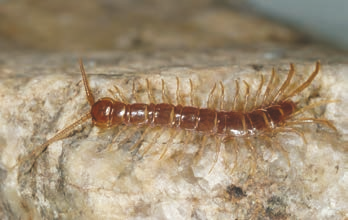
Centipede
Centipedes and millipedes occasionally find their way into the interiorscape, or may come in with new plant material. Centipedes prey on insects and are considered beneficial, although some people find their appearance in potting medium annoying. A teaspoon is useful for transferring them into a container for release outside. Millipedes feed on decaying organic debris or sometimes on plant parts, but rarely become a serious pest. Since they move slowly they usually can be removed by hand.
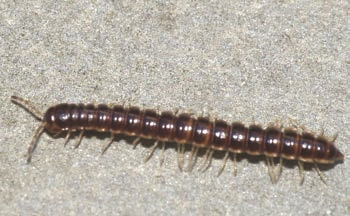
Millipede
Gray mold (Botrytis spp.)
Description and biology
Gray mold, or Botrytis, is a common and familiar plant disease found on both indoor and outdoor plants. Gray mold gets its name from the grayish, moldlike appearance of the fruiting bodies covering infected plant tissues. Several species of Botrytis cause gray mold, and spores of this humidity-loving fungus are thought to be present in most environments. The fungus lives through dry conditions as tiny, black, specklike resting stages called sclerotia. Under humid or wet conditions the sclerotia germinate to form a gray, cobweb-like growth called mycelium and quickly produces microscopic grapelike clusters of egg-shaped spores. Soon after the mycelium grows, the pathogen readily releases spores and the plant becomes covered with dusty, grayish-tan masses of conidia, or asexual spores. The spores are easily dispersed with the slightest air movement, and new infections can start on nearby plants with ample moisture.
The fungus attacks many plant parts, including flower petals, new succulent growth and particularly wounded, dying or dead tissues. It also may colonize in stems at points of attachment to stakes or trellises, or on leaves and stems that are in contact with a container or the soil surface. The fungus manufactures enzymes to soften plant cells before invading with mycelium. This advance attack allows the fungus to grow rapidly and increases spread. Botrytis survives in decaying plant material in or on the soil surface, and through sclerotia.
Signs and symptoms
Initial infections appear as soft, water-soaked brown or tan spots that may darken with age. It is especially prevalent on plants and plant parts located in areas of high humidity or in contact with the soil. The cottony, cobweb-like growth of the gray mycelium forms over the infected plant parts and is visible to the unaided eye.
By using a hand lens, you can see the characteristic grape-like cluster of spores that are supported by tiny stalks and cover the infected tissue. When the fungus releases spores, the grayish-tan masses of conidia appear as dust on the plant surfaces. You also may see the small, black, specklike sclerotia within the mycelial mat as the infection progresses. At more advanced stages, initially infected plant parts shrivel and decay, while new developing plant tissues are soon attacked.
Prevention and control options
You can minimize gray mold infection by promoting good air circulation and avoiding water build-up or pooling on plant surfaces. Planting densities and trellising techniques that provide maximum air movement throughout the plant canopy are beneficial. Keep the humidity below 85 percent and the temperature above 70°F to discourage disease development in the interiorscape.
High fertilizer rates can result in excessive growth of succulent tissue, which is particularly susceptible to infection. Remove and destroy diseased or dead plant material to prevent new or continuing infection. Leaves or branches in contact with the soil surface should be removed. When watering, avoid misting or overhead watering. Wet the soil and avoid splashing to keep the foliage dry. A well-drained soil mix and a container with drainage holes can reduce the buildup of excess moisture. Allow the soil to dry between waterings and water less frequently to further reduce the chances of infection. A fungicide registered for interiorscapes may be used against Botrytis according to the directions of the label.
Powdery Mildew
Description and biology
Powdery mildew is one of the oldest known and most easily recognized plant diseases. The three principal genera that cause powdery mildew are Erysiphe, Sphaerotheca and Podosphaera. Most powdery mildew fungi grow as thin layers of mycelium on the surface of the affected plant part.
Spores are the primary means of dispersal and make up the bulk of the powdery growth. The spores are produced in characteristic chains that can be seen using a hand lens. The spores are easily detached and can be wind-blown or water-carried to new hosts. Given favorable conditions, the spores can germinate in less than two hours, penetrating the leaf tissue with haustoria (a rootlike structure). The haustoria grow into the epidermal cells of the leaf and absorb liquids as food. A new crop of spores is produced every five to 10 days under ideal conditions of 97 to 99 percent relative humidity and temperatures between 57° and 75°F.
The fungus may cover an entire leaf or flower surface, or it may remain in discrete circular lesions on either side of the leaf. Under the powdery layer, the plant tissue may remain green while the surrounding tissue turns yellow. Spots becoming crusty or scablike may develop and small black specks called sclerotia may appear in the gray-white powder. Young leaves and shoots are particularly susceptible, although all above-ground portions of the plant can be attacked. Leaves actively growing and expanding may be twisted and misshapen. Infected buds often fail to open. Flower buds can become discolored or dwarfed, and usually fall off without producing flowers.
Prevention and control options
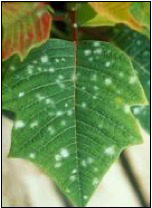
Powdery mildew (Family Erysiphaciae)
Avoid fertilizer applications that are high in nitrogen, since the rapidly growing succulent tissue is easily attacked by the fungus. High fertilizer rates also can increase the severity of an already present problem. Warm daytime temperatures followed by cool evenings favor the development of powdery mildew.
Maintaining an environment with a constant temperature helps in reducing the development of the disease. Spacing plants to allow good air circulation can reduce disease buildup in the entire collection. Some plant varieties are resistant to powdery mildew and should be considered if available for purchase. Washing leaves with a mild detergent may combat the disease. Consider using a fungicide registered for use in interiorscapes against powdery mildew and consult the product label for application directions.
Water mold rots
Description and biology
Pythium and Phytophthora are often called water molds because they have spores adapted to spread by water. Both fungi are found in almost all native soils and are common causes of root and stem rots.
Pythium spp.
Pythium is one of several water molds that cause damping-off disease in seed-propagated seedlings. The young seedlings appear soft and water soaked at or near the soil line. The stem tissue collapses and disintegrates, and the seedlings soon fall over. Pythium induced damping-off disease is most severe at temperatures of 50° to 64°F and most common in wet soils with a pH above 6.0.
Many mature plants are susceptible to Pythium root rot. Signs and symptoms vary with the susceptibility of a particular host. Common disorders in infected plants are wilting and leaf yellowing, with lower leaves dying off. Infected roots appear black and mushy and the outer covering (cortex) can easily be separated. The fungi can live as a saprophyte on dead plant and animal materials. Pythium can also act as a low-grade parasite, attacking young, succulent plant tissue. Plants with limited susceptibility may exhibit slow growth. Pythium root rot thrives in temperatures of 75° to 85°F and wet soils with a pH above 6.0.
Phytophthora spp.
Phytophthora affects both stems and roots of herbaceous and woody plants. The water mold can survive long periods of drought, cold and lack of food in a resting stage. There are reports the resting spores of Phytophthora can survive five or more years in soil. As water and a suitable host become available, the spores germinate to penetrate roots and branches directly. In herbaceous plants the infection begins as small, water-soaked lesions on the main plant stem at soil level. As the disease progresses, the lesions become soft and watery and the stem may eventually collapse.
Initial infections on woody plants appear as darkened areas and rarely extend completely through the stem. If the affected area is allowed to dry, the lesion will become brown and corky and the disease may fail to continue its development. If the disease progresses, dark sap may ooze from the affected spot. The inner layer of the bark may have reddish brown streaks. Roots affected by Phytophthora become brown and brittle and may be limited to the top part of a container.
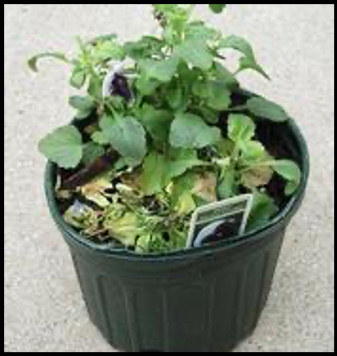
Phytophthora blight on pansy
A cross section of infected roots may show the central core or conducting tissue, yellowish or brown above the rot lesions. Both herbaceous and woody plants appear drought-stressed with wilted, discolored or stunted leaves. Plants with poor drainage are generally the first to exhibit signs of a Phytophthora infection. Symptoms are often initially limited to one branch or stem before spreading to the rest of the plant. Severely affected plants die but withered leaves remain for some time.
Prevention and control options
Good water management and clean, sterile potting soil are the two most important tools for controlling the water molds Pythium and Phytophthora. Only water plants as much as needed and avoid wetting leaves and stems. Don’t allow the leaves and stems to come in contact with the container or the soil surface, and be sure to use soil with adequate porosity and drainage. Pythium control may be aided by maintaining a low soil pH (below 5.5), and both diseases are less successful with proper fertilizer management (avoid too much or limited fertilizer). Before you purchase new plants, examine them closely for possible disease and be sure to remove and destroy all infected plant material. In some situations a fungicide labeled for use in the interiorscapes against Pythium or Phytophthora may be used. Be sure to read the product label for correct timing and use.
Root and stem rots
Description and biology
Much like the water molds, fungi such as Rhizoctonia, Fusarium and other species can cause both root and stem rots. Rhizoctonia lives in the potting medium and Fusarium on plants. Both are capable of persisting in the growing medium for several months.
Rhizoctonia spp.
Species of Rhizoctonia are present in virtually all soils. The fungi may survive in the soil on dead organic matter, or as spores (or other resting structures), for long periods of time. The fungus develops best in cool, wet soils, and studies have indicated that as soil temperature increases, the growth of the fungus decreases. High moisture in the potting medium and high humidity favor the development of the disease.
Rhizoctonia is one of several fungi that are responsible for damping-off, affecting both seeds and young seedlings (see also water molds: Pythium). Older plants infected with Rhizoctonia root or stem rot often appear limp and lacking vigor. Stem lesions first develop as water-soaked areas near the soil line and later turn brown or black, finally girdling the stem. Dark brown, somewhat dry lesions on roots and portions of the underground stem characterize root rot. Rhizoctonia can also cause aerial blight and leaf spots with symptoms that vary among plant species.
Fusarium spp.
The fungus Fusarium is composed of many pathogenic strains and capable of attacking various plant parts. It is not only responsible for root and stem rots, but leaf spots and wilts as well. Depending on the species of Fusarium, wounds may or may not be needed for infection. Water is required for Fusarium leaf spot inoculation. Numerous vectors are responsible for carrying this pathogen from plant to plant, including splashing water, human handling and insect activities.
Stem lesions often start near the soil line and are generally wet, mushy and sunken with purple margins. Infection also may occur on stems that have been cut or pruned. Typically, a dry rot appears first, then becomes mushy and ceases to progress when it reaches the center of the stem with complete loss of the diseased stem. Beige, orange or red fruiting bodies are sometimes visible in the midst of the lesions. When the fungus infects the roots, the plant becomes chlorotic and stunted.
Prevention and control options
Disease-free plant materials and good sanitation practices will help keep root and stem diseases under control. Water deeply and less frequently to keep the soil moisture low and avoid wetting the foliage and stems. Use a sterilized potting mix and make sure tools and containers are clean and sterile before and after each use. Since Rhizoctonia is a soilborne disease and present nearly everywhere, avoid using native soils and accidental introduction and infection. Since wounds allow some species of Fusarium easier access to the plant, handle plants with care to avoid injuries. Remove and destroy all infected plant material you find in the collection to reduce the spread of the diseases. Certain chemicals may be used in the interiorscape to control stem and root diseases. Consult the product label for specific uses and applications.
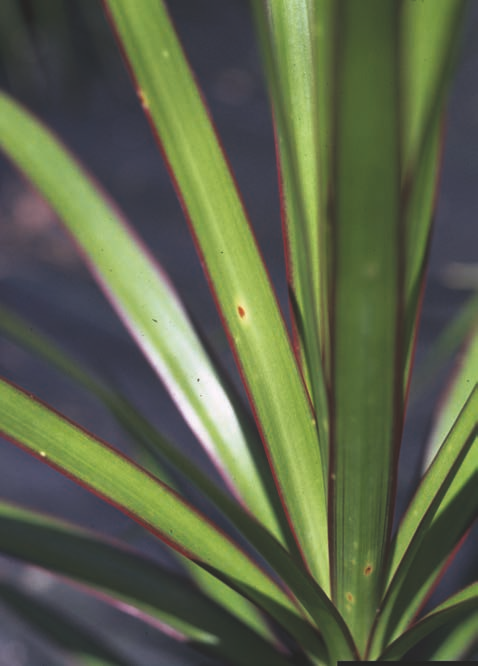
Fusarium symptoms
Fungal leaf spots
Description and biology
Many fungi can cause leaf spots diseases. Among common genera are Acremonium, Alternaria, Cercospora, Colletotrichum and Gloesporium, Coniothyrium (the imperfect stage of Leptosphaeria), Curvularia, Fusarium, Helminthosporium, and Leptosphaeria (the perfect stage of Coniothyrium). Botrytis (gray mold) can also cause leaf spotting and has a wide host range. Spores of Botrytis are only produced at prolonged high relative humidity of several hours. Each of these fungi is generally spread from infected plants by splashing spore-carrying water onto uninfected plants. Many of these fungi require water pooling for some time on the plant surface before infection can occur.
The signs and symptoms of each fungal infection vary among species and precise identification generally requires laboratory analysis. Fungal diseases often resemble other plant problems such as over-or under-watering, and without proper identification and control strategies, may spread through the collection. The information below provides some general descriptions of symptoms and how the various fungi may manifest themselves on an infected plant.
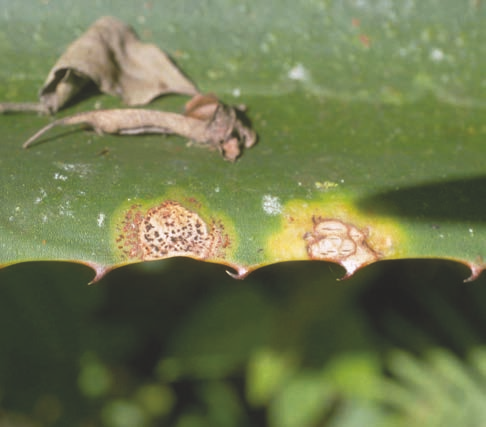
Coniothyrium fungus (leaf spot)
Acremonium spp. This fungus causes circular leaf spots with a reddish-brown to yellow border, rarely larger than 1 inch in diameter. They may be numerous, giving the leaves a shot-hole appearance. The youngest leaves are often most affected.
Alternaria spp. Leaf lesions of Alternaria first appear as small water-soaked spots that quickly enlarge to circular lesions of dead tissue up to 1 inch or more in diameter. The spots are generally dark brown to black with a yellow halo surrounding affected areas.
Cercospora spp. The leaf spots of this fungus are minute, sunken or slightly elevated, and generally found on the underside of infected leaves. The lesions may be tan, brown or purple and sometimes surrounded by a halo. Severely infected leaves may be chlorotic and drop off prematurely.
Colletotrichum and Gloesporium spp. The symptoms of these fungal infections, commonly called anthracnose, vary widely from one plant species to another. The disease may appear as very small water-soaked leaf lesions with a yellowish border in some plants. In other plants, the disease appears with leaf tips first turning first yellow, then tan and finally dark brown.
Coniothyrium spp. The leaf spots of this fungus first appear as dark brown to black elliptical lesions on the lower leaves of the infected plant. As the infection advances, the lesions become depressed and appear as tan spots with purple margins. Concentric zones of black and light brown tissue can be seen in mature spots (some of which reach an inch or more in diameter). Within the rings you may be able to see the tiny, black fruiting bodies of the fungus.
Curvularia spp. In the early stages of Curvularia infections, the small oval greenish lesions are generally found on the underside of the leaves. As they mature, the spots become tan to dark brown, and as the disease progresses the lesions may merge to form irregularly shaped spots. In severe infections, the leaves may be distorted and flowers fail to open.
Fusarium spp. Leaf spots resulting from Fusarium infection are first pinpoint-sized, water-soaked spots developing first on succulent immature tissue. The spots may later enlarge and become irregular with a reddish-brown center and yellow halo. In warm and wet conditions, the cream-colored fungal spores may be visible within the infected area. When the infection is severe, all new growth becomes infected.
Helminthosporium spp. The initial lesions of Helminthosporium are pinpoint-sized chlorotic spots on young leaves. As the disease progresses, the spots become spindle-shaped or elliptical, and turn tan to black with a yellow-green halo. Older lesions often develop dark, reddish-brown borders and sometimes merge to large areas of dead tissue. A leaf infected during development and not yet fully unfolded will blacken and fail to open.
Leptosphaeria spp. Newly formed lesions are yellow and water-soaked, later becoming brown to grayish in color. The older lesions are about 1 inch in diameter, sometimes with an outer halo of dark orange-yellow. Severely infected leaves will usually turn yellow and die.
Prevention and control options for fungal leaf spots
Many leaf spot fungi require several hours of free water on the leaf surfaces for infection to occur. Avoid splashing water on the leaves during watering to reduce the spread of fungal spores. Water early in the day and provide good air circulation to allow leaves to dry out quickly. Avoid giving plants too much fertilizer since this may result in the production of excessive succulent growth, which is most susceptible to many fungal diseases. Too little fertilizer may cause the plant to become weak and susceptible to an already present plant pathogen. Infected leaves should be removed and destroyed. Occasional repotting into well-drained, pasteurized soil using a clean container can aid in reducing plant diseases. Certain chemicals may be used to prevent the spread of some fungal diseases among interior plants (consult the product label for applicable use). The best solution for severe infections is to remove diseased plant parts or plants from the collection.
Systemic bacterial infections
Description and biology
Many bacteria, such as Erwinia, are capable of infecting the vascular tissues of plants to spread throughout the plant. When the pathogens begin to multiply in specific parts of the plant, they cause stem rots, wilts, blights and root rots. Stem infections caused by Erwinia are tan to brown, mushy, water-soaked lesions located on or near the soil line. A slimy ooze is produced on some hosts, and in many cases a distinct fetid or sour odor is present. Leaf infections first appear as pinpoint-sized, water-soaked spots. As the leaf lesions enlarge, concentric rings of light and dark tissue are commonly produced. In some hosts, infection occurs in the whorl of leaves where water collects to cause a severe blight of the stem and leaf tissue. Erwinia also may cause a severe root rot, which results in the wilting and collapse of the plant.
Most bacteria is spread by splashing water, unsanitary cultural practices or insect feeding activities. Entrance is usually through a wound or injured plant tissue. Since bacteria are carried in soil, plant material and water, spread can be fairly extensive in an interiorscape or in a home garden.
Prevention and control options
A systemic bacterial infection in a collection can usually be managed with less frequent watering and fertilizing. Avoid splashing or misting the leaves in order to prevent the transport of bacteria. Examine each plant for signs of disease before you purchase and choose only disease-free material. The use of pasteurized potting mixes and clean containers is also important. Removing and destroying infected plant parts may be useful, but keep in mind the systemic nature, as these diseases can spread through cuttings taken from an infected plant. Tools such as knives and clippers for managing plants also can spread the bacteria. Chemical applications are usually ineffective as the pathogen is widely spread throughout an infected plant.
Bacterial leaf spots and wilts
Description and biology
Species of the bacteria Pseudomonas and Xanthomonas can cause localized leaf spots or blights on plants. Leaf lesions are initially small, circular or irregular spots, dark green and water-soaked in appearance. The spots gradually enlarge, become angular and turn brown to black. The lesions are sometimes confined to interveinal areas but may occur anywhere on the leaf blade. Often, concentric rings of dark and light tissue surround the lesion, or a yellow or reddish halo encircles the affected area. Infected plants growing in high-moisture conditions may drop their leaves. Xanthomonas also may cause a vascular infection that causes the entire plant to wilt even when well watered. Infected stems may show the characteristic browning in the vascular strands.
The bacteria do not require a wound to gain entrance into the plant. High humidity and temperatures favor development of bacteria and overhead watering can hasten transmission. Since bacteria are carried in and on soil, water and plant material, there are many opportunities for infection.
Prevention and control options
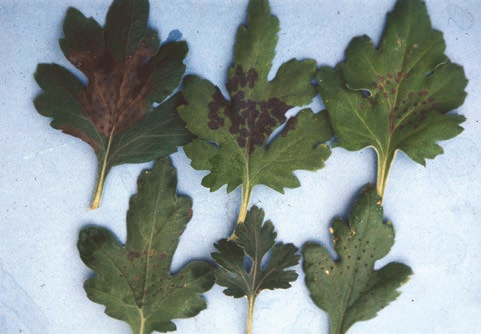
Pseudomonas (bacterial leaf spot) on chrysanthemums
Preventing and controlling bacterial leaf spots and wilts involves removing and destroying infected plant parts as soon as an infection is noticed. Remove infected tissues only when plants are dry and be sure to disinfect your tools (in 70 percent alcohol) and hands (wash with soap and water) between cuttings. Buy only healthy plants and use pasteurized potting mix and clean containers.
Virus diseases
Virus diseases of interior plants are less common than diseases caused by fungi or bacteria. Viruses live within the cells of an infected plant and can spread unaided from cell to cell. Viruses require physical assistance to spread from one growing plant to another. Viruses also need a wound through which they gain entrance into a plant. Viruses are most often spread through insect feeding activities and cuttings taken from infected material. Less frequently, viruses also can spread by seed. Insects such as aphids and leafhoppers are important vectors for transmitting viruses. Mealybugs, thrips and whiteflies also transmit viruses. Other vectors that sometimes carry viruses include mites, nematodes and soil fungi.
Signs and symptoms
Leaves of a plant infected with a viral disease often provide the first and most noticeable symptoms. The leaves of an infected plant may appear mottled or with a mosaic of irregular-shaped dark and light green areas. Vein banding, flecking, ring-like spotting and yellow blotching of the leaves are other common expressions of viral infections. Occasional growth abnormalities may appear that resemble the distortion and damage caused by a misapplication of a herbicide. Infected plants may be stunted, dwarfed, less vigorous or are growing more slowly than healthy, uninfected plants.
Prevention and control options
Once virus diseases have been established, they are difficult to manage. The most effective method for the control of viruses is to avoid purchasing infected plants and use resistant varieties. Insect populations need to be monitored and controlled since many insects are vectors and able to carry and spread viruses. Infected plants should be removed from the collection and destroyed.
Noninfectious abiotic plant disorders
The environment of interiorscapes can be variable and unpredictable. The light, moisture, temperature and air quality of the indoor atmosphere often differ from the plant’s natural habitat. Consequently, the interior plant is faced with an assortment of interrelated factors that influence overall growth and appearance.
Nutrient availability is important for plants. Most interior plants suffer from a lack or imbalance of fertilizer and nutrients to support their growth.
Pesticide misuse can contribute to several disease-like symptoms, some of which are more serious than the pest they were intended to eliminate. Physical damage resulting from a dog, cat or other pet grazing in your collection, accidentally overturning or dropping a plant, or some other tissue damaging mishap can lead to unsightly or unhealthy plants.
Most noninfectious, abiotic plant disorders resemble disease symptoms, though some are easily distinguished merely by attempting to correct the problem and observing the results. The chart below lists the most common symptoms and causal factors of several common abiotic plant disorders.
Causal Factors and symptoms
| Insufficient light | Excess light | Sudden increase in light | Underfertilization | Overfertilization | High soil salts | Underwatering | Overwatering | |
|---|---|---|---|---|---|---|---|---|
| Lower leaves turn yellow | X | X | X | X | ||||
| New leaves too small | X | X | X | X | X | |||
| Little or no new growth | X | X | X | X | X | X | ||
| Bud or flower drop | X | X | ||||||
| Leaf drop | X | X | X | X | X | |||
| Top or entire plant yellow | X | X | X | |||||
| Loss of color variation | X | |||||||
| Brown or black leaf spots | X | X | X | X | ||||
| Leaves curl or cup | X | |||||||
| Brown leaf margins or tips | X | X | X | X | X | |||
| Wilting | X | X | X | |||||
| White or yellow leaf spots | X | X | ||||||
| Spindly growth | X | |||||||
| Root loss or rot | X | X | X | |||||
| Leaf or petiole rot | X | X | ||||||
| Blackening of new growth | X | |||||||
| White crust on soil surface | X | |||||||
| Total plant collapse | X |
| Cold water on leaves | Temperature too low | Temperature too high | Hot or cold drafts | Gas fumes | Root bound | Low humidity | |
|---|---|---|---|---|---|---|---|
| Lower leaves turn yellow | X | X | X | ||||
| New leaves too small | |||||||
| Little or no new growth | X | X | X | X | |||
| Bud or flower drop | X | X | X | ||||
| Leaf drop | X | X | X | X | X | X | |
| Top or entire plant yellow | X | ||||||
| Loss of color variation | |||||||
| Brown or black leaf spots | X | X | |||||
| Leaves curl or cup | X | X | X | ||||
| Brown leaf margins or tips | X | X | X | X | X | ||
| Wilting | X | X | X | ||||
| White or yellow leaf spots | |||||||
| Spindly growth | X | ||||||
| Root loss or rot | |||||||
| Leaf or petiole rot | |||||||
| Blackening of new growth | |||||||
| White crust on soil surface | |||||||
| Total plant collapse |
Integrated Pest Management
Choosing control options that suit your need and the situation
Integrated pest management is a holistic approach to managing pests. IPM is ecosystem-based to consider cultural practices, the environment, life cycles of plants and pests, and the use of various control methods. Available options are evaluated and selected for the long-term ecological impact and management rather than eradication of a specific pest species. Methods that minimize the risk for human health, the environment and nontargeted organisms are evaluated, selected and applied. IPM strategies incorporate various methods such as mechanical, physical, chemical and biological controls. Current and future effects are evaluated for an integrated approach to reduce long-term impacts while managing and controlling immediate pest attacks.
The interiorscape is an ideal environment for the use of IPM. Plant needs and tolerance for pest damage can be evaluated to determine the severity of a pest problem. Several aspects revolving around the pest identity or cause of a perceived problem need to be considered. An observed insect may not feed on the plant as a pest, but rather is a beneficial predator using a small insect or mite population as a food source. Brown leaf tips may be due to a misapplication of a pesticide rather than lack of water. Evaluating the situation and choosing a suitable solution is important for successful plant management.
Once the pest is identified, you need to decide the tolerance level for the pest. Total elimination may not be desirable or possible unless plants are removed from the collection. By examining the plants and monitoring pest activities, you can acquire a good sense of the progression and begin to consider available control methods. Sometimes control measures can be simple such as requiring less water or the relocation of plants to a more favorable setting.
Serious pest problems usually require some level of intervention. Biological, physical, mechanical and chemical controls can directly affect the activities of a pest. Direct control methods need to be evaluated when a pest has been determined harmful or intolerable. Education on available direct control options is needed to choose one or a combination of several methods to most safely and effectively reduce the pest population to tolerable levels.
Pest control in an interiorscape needs to include both management activities and the climate surrounding the plants. Examine the cultural practices, choice of soil and fertilizer, watering protocols, and the climatic conditions where the plants are growing. All options should be evaluated prior to evaluating a strategy. After a control strategy has started, follow up and monitor the success or failure within your collection. If the strategy is not working, reconsider and redesign the approach to improve effectiveness. If all fails, consider removing the plant and the pest program and then replace with a different plant or variety.
About Pesticides
Any substance used to control, eliminate or kill a pest is classified as a pesticide. Fungicides, insecticides and miticides are examples of pesticides created for a specific group of pests. Several types of pesticides are available with synthetically produced chemicals may be the best known. Biopesticides are naturally occurring substances derived from animals, plants, bacteria or mineral sources to kill or inactivate a pest. Microbial pesticides consist of microorganisms such as bacteria, fungi or viruses, and are often very specific for a particular target disease or pest. If pesticides are included in a pest management strategy, several items need to be considered.
The Pesticide Label
All pesticides have labeling that is unique to a specific product. The label lists approved uses of pesticide as determined by the Environmental Protection Agency (EPA). The label is the law and any use not listed on the label is strictly prohibited. All information needed for the safe and legal use of the particular product such as its ingredients, application rates, hazards and more is included on the label. Consultants or sales personnel recommending a use of a pesticide that is NOT listed on the label are breaking the law.
The label on a pesticide is not necessarily limited to the printed label on the container. Supplemental information such as leaflets or attachments, and referenced sources also are considered part of the legal label. It is the responsibility of the applicator to comply with all instructions and information provided on or appended to the label.
The pesticide label usually has three listed name categories: the brand, trade or product name; the chemical name; and the common name. The brand, trade or product name is specific to the manufacturer and may vary for pesticides using the same active ingredients from different manufacturers. Do not choose a pesticide product based on brand name alone. The chemical name is the scientific name indicating the chemical structure of the active pesticide ingredient. The common name is usually a shorter version of the often complex and complicated chemical name.
Each label has a distinctly displayed signal word to communicate the relative acute pesticide toxicity for humans. The signal word lets you know the anticipated danger and level of required safety precaution using the pesticide. The signal words are DANGER, WARNING and CAUTION.
A DANGER classification is given to products that are highly toxic orally, dermally or through inhalation, or can cause severe eye or skin burning. All pesticides that are highly toxic (orally, dermally or through inhalation) also will carry the word POISON and a skull and cross-bones symbol. A teaspoon or less taken orally could kill an average-sized adult.
WARNING indicates that a product is moderately toxic orally, dermally or through inhalation, or can cause moderate eye and skin irritation. Ingesting as little as a teaspoonful or up to a tablespoonful could kill an average-sized adult.
CAUTION is applied to a product with slight toxicity to relatively nontoxic orally, dermally, or through inhalation, or that can cause slight eye and/or skin irritation. As little as an ounce to more than a pint taken by mouth could kill an average-sized adult.
The pesticide label has additional important information that further directs you to the proper and safe use of the pesticide. The INGREDIENT STATEMENT lists the official chemical names and/or common names of the active ingredients. Inert ingredients do not need to be identified, but are listed as a percent of the total contents.
The ROUTE OF ENTRY STATEMENTS indicate what areas of your body (route of entry) are most vulnerable and particularly need to be protected, such as mouth, skin and/or lungs. These statements are found immediately following the signal word or directions are provided for where this information may be found on the label.
The pesticide label has a STATEMENT OF PRACTICAL TREATMENT or FIRST AID STATEMENT with instructions for what to do in case of a poisoning emergency. All DANGER labels and some WARNING and CAUTION labels have a section on first aid, signs or symptoms of poisoning, notes to physicians, antidote treatment and an emergency telephone number.
PERSONAL PROTECTIVE EQUIPMENT (PPE) STATEMENTS tell you the clothing or equipment required for specific tasks such as application, mixing or loading. These statements indicate the minimum required clothing and equipment along with requirements for posting and notification prior to, during and after a pesticide application.
A pesticide may carry a RESTRICTED USE PESTICIDE STATEMENT to indicate that the EPA has classified the particular pesticide for restricted use only. Any pesticide classified as “restricted” must carry the following statement: “RESTRICTED USE PESTICIDE. For retail sale and use only by certified applicators or persons under their direct supervision and only for those uses covered by the certified applicator’s certification.”
Most pesticide labels have some GENERAL ENVIRONMENTAL STATEMENTS as a reminder of the potential harm improper or careless use of the pesticide can have on the environment. Some pesticides are classified “RESTRICTED USE” because of their potential hazard to the environment alone.
If a particular pesticide is especially hazardous to wildlife or other organisms, the label will carry SPECIAL TOXICITY STATEMENTS to alert to the need of required caution using the pesticide. If the pesticide is likely to harm plants, the label also will warn of the phytotoxic potential.
Pesticide labels carry a REENTRY STATEMENT that tells you how long you must wait before you and others can reenter the treated area without wearing the required personal protective clothing and equipment.
All pesticide labels contain various additional PRECAUTIONARY STATEMENTS that assist you in taking the proper provisions to protect anyone (including domestic animals) who may be exposed.
All pesticide labels provide you with general information on storage and disposal of the pesticide and the container. Determine the best storage and disposal methods for your situation and location by contacting the proper authorities.
The illustration on page 23 shows a hypothetical pesticide product label and identifies each of the label statements mentioned above.
Pesticide Formulations
Products used for the control of pests on interior or houseplants are often marketed premixed and ready for use in a spray bottle or other type of application device. Ready-to-use products are convenient, and mixing errors are virtually nonexistent.
Emulsifiable concentrates usually contain an active ingredient, usually one or more petroleum-based solvents and an emulsifier that allow for easy mixing without much agitation. These products are relatively easy to handle and store, but are usually highly concentrated. A small calculation error may result in a large dilution problem. These concentrates are also easily absorbed through the skin, generally flammable and may be corrosive. The petroleum-based solvents may cause plant damage (phytotoxicity) more often than with other formulations.
Dusts formulations are ready to use and contain a low percentage of active ingredient plus a very fine, dry inert carrier such as clay or chalk. In situations where it is undesirable to apply water to the foliage, dusts may provide the right alternative. Because dusts are always used in a dry form, drifts into nontarget areas and the possibility of inhalation can be disadvantageous. Dusts do not stick as well on plants as some other formulations.
Soluble or wettable powders are finely ground and look like dust. Most are mixed with water before application. They are less likely than liquid concentrates to cause plant damage since they don’t contain petroleum products. Powders are not as easily absorbed through the skin or eyes compared to liquid formulations. Disadvantages include the hazard of inhalation and the need for constant agitation to keep the powder in suspension. These formulations are difficult to mix completely in hard or alkaline water and may leave a residue on treated leaves.
Granular products are often designed for application to the soil surface or incorporated into the soil. Granules require no mixing and do not pose as great a hazard from inhalation as do dusts and powders. These formulations are designed to control weeds, nematodes or insects living in the soil.
An adjuvant is added to a pesticide to increase its safety or effectiveness. These products may be included in the formulation, or the product label may direct you to add an adjuvant during mixing. Some adjuvants are spreaders to allow the pesticide to form a uniform layer over a leaf surface, or stickers for better adherence to a treated surface.
Pesticides are often described by the way they interact or control a disease or insect. Contact pesticides are commonly applied to the leaves and stems of plants to cover present insects or fungi. As the name implies, the fungus or insect is killed upon contact with the pesticide. A soil drench also may be used as a contact pesticide. In this type of treatment, the soil is saturated with a dilute pesticide solution. Because the insect or fungus is killed through contact with the pesticide, there is no need for feeding or other entry into the pest organism.
Systemic fungicides or insecticides are absorbed through the leaves or roots of a plant and moved through the vascular system to protect all parts of the plant. Systemics allow for relatively long lasting control, killing pests that arrive and feed on the plant treated with the chemical. Systemics can be sprayed onto the foliage, applied as granules and watered into the soil, or mixed with water and used as a soil drench.
Five Steps to Safe Use of Pesticides
All pesticides have a label that includes the content, purpose and formulation of the product. The label also provides information on target pests and the crops or plants that have been approved for treatment. Please review the following five steps before making any pesticide applications and remember: THE LABEL IS THE LAW.
- READ THE LABEL BEFORE BUYING. Make sure the product is labeled for the plant you intend to treat and the pest to control. Check the label for approved site locations. If the label does not specifically state for interior use, the product cannot legally or safely be used.
- READ THE LABEL BEFORE MIXING. Use the recommended rate for the type of application and the particular plant species. It is illegal to use a higher rate than recommended. Using a higher rate may pose a health hazard to humans or pets and can also cause plant injury or death. A lower strength than the recommended rate is legally allowed, but keep in mind that the treatment may be ineffective and allow the pest to build resistance to the pesticide. Follow any special instructions for the use of adjuvants, surfactants or spreaders. Use the indicated personal protective equipment (PPE) such as protective clothing, glasses and gloves during mixing and application.
- READ THE LABEL BEFORE APPLYING. Check for instructions referring to any specific conditions before making an application. Some examples of special instructions include: “Do not apply if the temperature is above 90°F,” or “Do not apply if the plant is wilted or severely stressed.”
- READ THE LABEL BEFORE STORING. Always store pesticides and other chemicals in their original packaging. Never transfer or store chemicals in any food or beverage containers. Follow recommendations for storage conditions and sites. An example of this type of direction is: “Store away from heat or flame.”
- READ THE LABEL BEFORE DISPOSING. Unused pesticides or empty containers must be disposed according to label instructions. Empty and partially filled household pesticide containers may be wrapped in paper and discarded for curbside pickup, according to EPA. However, many municipalities have rules and regulations prohibiting this disposal method of specific household items. Communities often conduct cleanup programs and encourage citizens to turn in unwanted pesticides during an annual cleanup day or week. Other communities may have a hazardous waste drop off site.
References
Bessin, R. 2019. Interior plantscape pest control. Kentucky Pesticide Education Program, Department of Entomology, University of Kentucky. http://www.uky. edu/Ag/Entomology/PSEP/cat19eval.htm
Chase, A.R. 1987. Compendium of Ornamental Foliage Plant Diseases. St. Paul, MN: The American Phytopathological Society.
Horst, Kenneth R. 2013. Westcott’s Plant Disease Handbook. Springer Science+Business Media, Dordrecht https://doi.org/10.1007/978-94-007-2141-8
Lucas, G.B., C.L. Campbell and L.T. Lucas. 1992. Introduction to Plant Diseases: Identification and Management, 2nd edition, Chapman & Hall, New York.
Nelson, P.V. 2012. Greenhouse Operation and Management, 7th edition. Pearson Prentice Hall. Upper Saddle River, NJ
Pittenger, D.R. and D.R. Hodel. 2020. Pest notes: houseplant problems, UC ANR Publication, Oakland CA. http://ipm.ucanr.edu/PDF/PESTNOTES/pnhouse-plantproblems.pdf
Pscheidt, J.W. and C.M. Ocamb. 2021. Pacific Northwest Plant Disease Management Handbook (online). Corvallis, OR: Oregon State University. https://pnwhand-books.org/plantdisease
Steiner, M.Y. 1987. Biological Pest Management for Interior Plantscapes, 2nd edition. Vegreville, AB: Alberta Environmental Centre, Canada
Bug-Off (1)
(2) Insecticidal Soap
(3) Concentrate
(4 & 5) ACTIVE INGREDIENT ...................................................By Wt.
Potassium Salts of Fatty Acids (Insecticidal soap):......49.0%
INERT INGREDIENTS: .....................................................51%
TOTAL .........................................................................100.0%
NET CONTENTS 32 FL. OZ. (6)
DIRECTIONS FOR USE (7)
It is a violation of federal law to use this product in a manner inconsistent with its label.
Always use freshly mixed solution. Use soft water whenever possible. Do not use on new transplants or newly rooted cuttings. Do not apply to plants in full sun. For control of ADELGIDS, APHIDS, EARWIGS, MEALYBUGS, CRICKETS, GRASSHOPPERS, LACEBUGS, TENT CATERPILLARS, PLANT BUGS, PSYLLIDS, SCALES, SPIDER MITES, THRIPS and WHITEFLIES on ornamental plants and vegetables grown in and around the home. Mix 2.5 fluid ounces (5 tablespoons) per gallon of water. Apply whenever insects appear, being sure to thoroughly wet both surfaces of infested leaves and branches. For aphids and mealybugs, spray again after 2 to 3 days. For other pests, spray weekly for 2 to 3 weeks or as needed. INDOOR PLANTS: Use as directed above. Be sure that spray penetrates dense foliage to wet all infested surfaces. Do not use on crown of thorns; test spray other euphorbias, jade plants, palms and delicate ferns before making full application. For ROOT MEALYBUGS on African violets, drench with tepid solution of 1 tablespoon per quart of water. VEGETABLES: Use as directed above on TOMATOES, PEPPERS and EGGPLANT to control aphids, spider mites and whiteflies up to day of harvest; on COLE CROPS to control aphids and leaf hoppers up to day of harvest; on CUCUMBERS, SQUASH and MELONS to control aphids, spider mites, squash bugs and whiteflies up to day of harvest; and on BEANS and PEAS to control aphids, leafhoppers, grasshoppers and spider mites up to day of harvest.
PRECAUTIONARY STATEMENTS (8)
Hazards to humans and domestic animals
CAUTION: Harmful if swallowed. Avoid contamination of feed and food stuff. Avoid eye contact. (9 & 10)
First aid (statement of practical treatment): In case of eye contact, flush with plenty of water. Get medical attention if irritation persists. (11)
Environmental hazards: Keep out of lakes, streams and ponds. (12)
Physical or chemical hazards: Do not use or store near heat or open flame. (13)
STORAGE AND DISPOSAL
Storage: Store in a cool place and keep container tightly sealed. (14)
Disposal: For disposal of unused product, securely wrap original container in several layers of newspaper and discard in trash. Do not reuse empty container. Rinse thoroughly before discarding in trash. (15)
Distributed by
BUG, INC.
123 Whitefly Lane
Cicely, AK 00011
EPA Reg. No. 946-23
EPA Est. No. 3344723-987-67
- BRAND OR TRADE NAME
- TYPE OF PESTICIDE
- FORMULATION
- ACTIVE INGREDIENT CHEMICAL NAME
- ACTIVE INGREDIENT COMMON NAME
- NET CONTENTS
- DIRECTIONS FOR USE
- PRECAUTIONARY STATEMENTS
- SIGNAL WORD
- ROUTE OF ENTRY
- FIRST AID
- ENVIRONMENTAL HAZARDS
- PHYSICAL OR CHEMICAL HAZARDS
- STORAGE
- DISPOSAL
- NAME AND ADDRESS OF MANUFACTURER
- EPA REGISTRATION NUMBER
- EPA ESTABLISHMENT NUMBER
Meriam Karlsson, Professor of Horticulture. Originally written by Wayne Vandre, Extension Horticulture Specialist, Lois Bettini, Land Resource Program Assistant, and Mary Comeau, Agriculture Research Program Assistant.
Revised July 2021
